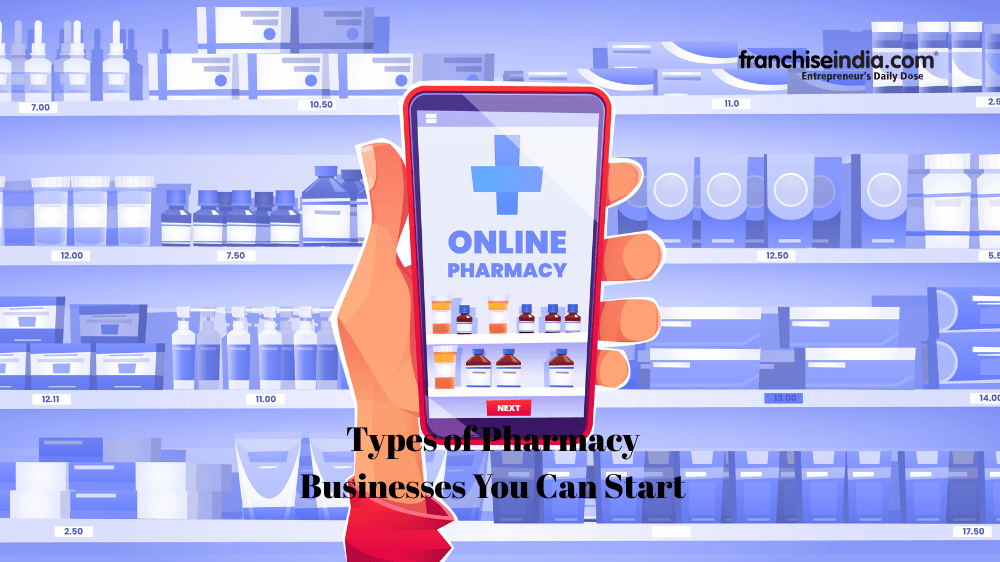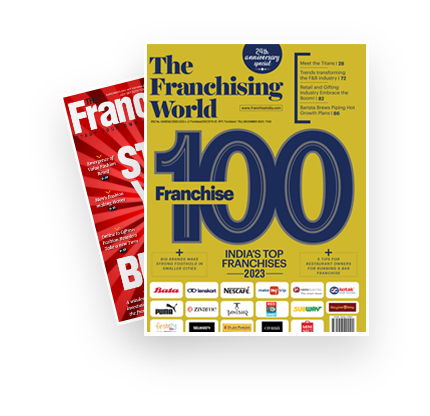
The healthcare and pharmaceutical sector in India has experienced tremendous growth over the past decade. With growing health awareness, growing lifestyle illnesses, expanding insurance coverage, and the growth of urban and semi-urban markets, the demand for medicines and medical supplies has increased significantly. As a result, opening a pharmacy (medical shop) has emerged as one of India's most reliable, profitable, and long-term business opportunities. Starting a pharmacy business requires careful planning, regulatory approval, and a strong understanding of the healthcare and retail market. The first step is to decide the type of pharmacy you want to open—a retail medical store, wholesale distribution, online pharmacy, or franchise outlet.
In this article we are going to cover the process of how we can start a pharmacy business, including the types, eligibility, licenses, and investment. Read this article till the end to clear all your doubts about this.
Also read: 21 Successful E-commerce Business Ideas in India
Step-by-step approach of how to start a pharmacy business:
1. Types of Pharmacy Businesses You Can Start

There are different types of pharmacy business models you can choose from, and the right option depends on your location, investment capacity, and long-term goals. If you’re thinking about opening a pharmacy, you’ve got a few different ways to go about it.
- A retail pharmacy or medical store is the most common and the classic option; that’s where you sell prescription meds and over-the-counter health stuff straight to customers. It’s a straightforward setup. If you’re just starting out or want a shop with steady walk-ins, this is usually the way to go.
- A wholesale pharmacy, on the other hand, deals in bulk supply and distributes medicines to retailers, hospitals, and clinics. You’ll need more cash upfront, a bigger space, and solid relationships with suppliers. It’s a different ballgame.
- For folks interested in tech and scaling up, there’s the online or e-pharmacy route. Here, you take orders through a website or app and deliver meds right to people’s doors. It sounds convenient, but you’ll need tight verification processes and really good logistics to pull it off.
- Another option is a hospital- or clinic-attached pharmacy, where the pharmacy operates within medical premises and serves patients directly, usually through partnerships with healthcare providers.
For most first-time entrepreneurs, starting with a retail pharmacy (standalone medical store) is the most practical and manageable approach, offering consistent demand and easier operations.
2. Eligibility & Educational Requirements
.png)
To start a pharmacy business, you do not necessarily need to have a pharmacy-related educational background yourself. Anyone can own and operate a pharmacy as an entrepreneur. However, to legally dispense medicines, you must have a qualified, licensed pharmacist in the store during business hours.
This pharmacist should hold either a D.Pharm (Diploma in Pharmacy) or B.Pharm (Bachelor of Pharmacy) degree and must be registered with the State Pharmacy Council. Their registration certificate is required when applying for the drug license. If the business owner already holds one of these qualifications and is registered as a pharmacist, then there is no need to hire someone else for this role. But if the owner is not a pharmacist, they must employ a licensed pharmacist to manage the dispensing of medicines and maintain regulatory compliance. This rule makes sure medicines are handled, stored, and given out safely and professionally.
3. Legal Licenses & Permits Required
.png)
Setting up shop means ticking off a bunch of legal boxes.
- The most important approval is the Retail Drug License (RDL), which is obtained from the State Drugs Control Department and may cost between ₹3,000 and ₹15,000 depending on the state. Costs vary by state, but expect anywhere from ₹3,000 to ₹15,000.
- Your pharmacist also needs a valid registration—usually ₹500 to ₹2,000. You’ll need to register for GST, which you do online, and if you get help with that, there might be extra fees.
- A Shop and Establishment Certificate and a Trade License from the local municipal authority are also required, usually costing ₹1,000–₹5,000 and ₹1,000–₹8,000 respectively. In some cases, a No Objection Certificate (NOC) for the premises may be needed.
The entire licensing process can take 15 to 45 days, depending on the state regulations and document verification.
Also read: Top 15 Healthcare and Wellness Businesses to Consider in India
4. Choosing the Right Location
.png)
The location of a pharmacy plays a major role in determining its success and customer flow, as picking the right spot for your pharmacy is huge.
- Pharmacies perform best when situated near hospitals, clinics, diagnostic centers, or in densely populated residential areas where there is a constant demand for medicines. Markets, spots near bus stands, or anywhere with lots of foot traffic work well.
- The ground floor is best, so people can find you easily—especially older customers or those in a hurry. As per legal requirements, a retail pharmacy should have at least 100 sq. ft. of space, whereas a wholesale pharmacy needs a minimum area of 150 sq. ft. Rental costs vary depending on the city and location.
- In smaller towns, shop rents generally range from ₹8,000 to ₹18,000 per month, while in medium-sized cities the rent may be between ₹15,000 and ₹35,000. In the big metros, you’re looking at ₹30,000 to ₹1,00,000 or even more if you want a prime spot.
5. Interior Setup & Equipment
.png)
Setting up a pharmacy requires proper interior arrangement and essential equipment to ensure efficient storage, accurate billing, and a professional appearance. First up, storage racks or shelves: these keep your medicines neat and easy to find, and depending on your shop’s size, you’ll spend anywhere from ₹25,000 to ₹1,50,000. Then there’s the pharmacy counter with a billing desk—expect to pay ₹10,000 to ₹40,000 for that. A refrigerator is a must for things like insulin and vaccines, usually costing ₹10,000 to ₹20,000.
- You’ll also need a computer system with billing software and a printer. That setup runs about ₹20,000 to ₹60,000.
- Air conditioning isn’t strictly necessary, but it really helps with customer comfort and keeps your medicines in better shape, so budget ₹25,000 to ₹45,000 if you want one.
- For security, CCTV cameras cost between ₹5,000 and ₹20,000. Don’t forget signboards and branding, which can add another ₹5,000 to ₹25,000.
All in, you’re looking at a total setup cost—excluding the medicine stock—of roughly ₹60,000 to ₹3,50,000, depending on how big and fancy you want the place.
6. Inventory & Initial Stock Purchase
.png)
When it comes to your initial stock, how much you’ll need to invest depends mostly on location and who you expect to serve.
- In a smaller town, starting with inventory worth ₹1,00,000 to ₹3,00,000 is usually fine.
- If you’re opening in a city, plan for ₹3,00,000 to ₹7,00,000 to cover more demand and a wider range of products.
- For high-traffic or premium stores, you might need ₹7,00,000 to ₹15,00,000 to keep your shelves stocked and customers happy.
Start with the essentials: antibiotics, painkillers, diabetes and blood pressure meds, and thyroid medicine. Add OTC staples like cough drops, paracetamol, digestive syrups, pain relief sprays, and fever reducers. Personal care—shampoos, soaps, sanitizers—always sells. Baby care products (diapers, infant formula) and basic health devices (thermometers, glucometers, BP monitors) are good to have. Surgical supplies like gloves, bandages, and syringes round out the basics. Most pharmacies offer a 5–15% discount on medicines to bring in customers. Your profit margin will depend on whether you’re selling branded, generic, or specialty medicines, but keeping your stock balanced and refreshed is what really keeps customers coming back.
Also read: Top 15 Trending QSR Business Ideas You Can Start in 2026
7. Supplier & Distribution Network
.png)
Sourcing medicines isn’t too complicated, but having more than one supplier is smart. Local distributors and wholesalers are the go-to for speed and sometimes offer credit, which helps with cash flow. Company stockists or CNF agents supply straight from pharma companies, which means better margins and bigger discounts. These days, a lot of pharmacists also use online B2B platforms to compare prices and get quick delivery—super handy. Juggling a mix of suppliers keeps your shelves full, prices steady, and business running smoothly even if one supplier has issues. Buying from them can provide better profit margins and larger discounts due to reduced intermediaries.
Additionally, many pharmacies now use online B2B pharma platforms, which allow easy price comparison and doorstep delivery, saving time and helping you choose the most cost-effective options. Having multiple suppliers is important so that you can continue to meet customer demand even if one source experiences delays or shortages. This approach ensures smooth operations, stable pricing, and consistent product availability.
8. Profit Margins in Pharmacy Business
.png)
Profit margins in a pharmacy really depend on what you’re selling.
- Generics medicines usually bring in the most profit, with margins anywhere from 30% to 60%. They’re a big driver for revenue.
- Branded medicines, on the other hand, have slimmer margins—think 15% to 25%—but people keep buying them, so the sales stay steady.
- Over-the-counter products and wellness items tend to offer 20% to 40% margins and move pretty fast, so you see cash coming in regularly.
- Cosmetics and baby care goods can give you 25% to 50% margins, so they help bump up earnings too.
- Surgical supplies are a different story—important to stock, but the margins are usually on the lower side, about 10% to 20%.
When you look at the profits, a small or medium pharmacy selling ₹1.5 lakh to ₹3 lakh a month will usually earn ₹20,000 to ₹45,000 profit. If you push sales up to ₹3 lakh to ₹6 lakh, profits can jump to ₹40,000 to ₹90,000. Pharmacies near hospitals or clinics often make more and grow faster, just because of the constant flow of patients.
9. Hiring Staff
.png)
We need to hire people to help around the pharmacy; they may vary according to their roles. They must be well-trained staff and specialists, and their salary ranges and role responsibilities mentioned are realistic for small and medium-sized pharmacies in India.
- The licensed pharmacist, who is responsible for dispensing medicines and maintaining regulatory compliance, usually earns between ₹12,000 and ₹30,000 per month, depending on experience and location.
- A sales or counter assistant supports customer queries, billing, and shelf management, with salaries commonly ranging from ₹8,000 to ₹18,000.
- Some pharmacies also employ a delivery person, especially if offering home delivery services; this role generally pays ₹7,000 to ₹15,000 per month.
- Proper training is essential, as staff should know how to read prescriptions, store temperature-sensitive medicines like insulin or vaccines, and talk to customers in a way that’s clear and friendly. Good training builds trust, keeps customers coming back, and makes sure nobody messes up something important.
Also read: Top 7 Most Successful Businesses to start in 2025-26
10. Running a Successful Pharmacy
.png)
If you want your pharmacy to grow and keep customers loyal, focus on the basics.
- Keep shelves tidy and organized so people can find what they need and you can work fast when it gets busy.
- Always have essential and fast-moving medicines in stock, since people expect to get what they need right away.
- Build relationships with nearby clinics, labs, and nursing homes, because they’ll send you regular business.
- Use pharmacy billing and inventory software to keep track of stock, avoid expiry losses, and reorder on time.
All of these steps make your service better, keep customers happy, and lift your profits.
Final note
Starting a pharmacy in India is a steady, long-term business. People always need medicines, so demand doesn’t really drop off. If you pick a good location, get the right licenses, keep your inventory solid, and treat customers well, you can earn well and even help your community. Sure, you need to invest and follow the rules, but the rewards make it worth it—especially for entrepreneurs, healthcare professionals, or families looking for steady income. Focus on being accessible, building trust, setting fair prices, and working with reliable suppliers, and your pharmacy can grow into a respected business that really makes a difference.
You might also like: Top 15 MSME Business Ideas In India For 2025-26

